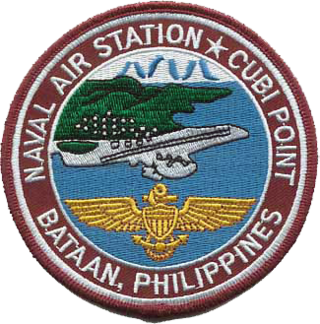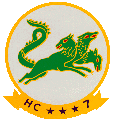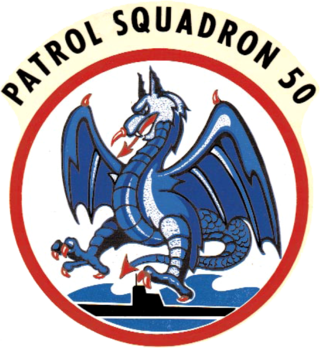
The Grumman C-2 Greyhound is a twin-engine, high-wing cargo aircraft designed to carry supplies, mail, and passengers to and from aircraft carriers of the United States Navy. Its primary mission is carrier onboard delivery (COD). The aircraft provides critical logistics support to carrier strike groups. The aircraft is mainly used to transport high-priority cargo such as jet engines and special stores, mail, and passengers between carriers and shore bases.

Carrier onboard delivery (COD) is the use of aircraft to ferry personnel, mail, supplies, and high-priority cargo, such as replacement parts, from shore bases to an aircraft carrier at sea. Several types of aircraft, including helicopters, have been used by navies in the COD role. The Grumman C-2 Greyhound has been the United States Navy's primary COD aircraft since the mid-1960s.

A carrier air wing is an operational naval aviation organization composed of several aircraft squadrons and detachments of various types of fixed-wing and rotary-wing aircraft. Organized, equipped and trained to conduct modern US Navy carrier air operations while embarked aboard aircraft carriers, the various squadrons in an air wing have different but complementary missions, and provide most of the striking power and electronic warfare capabilities of a carrier battle group (CVBG). While the CVBG term is still used by other nations, the CVBG in US parlance is now known as a carrier strike group (CSG).

Fighter Squadron 114 (VF-114) was a fighter squadron of the United States Navy that was active from 1945 through 1993. Nicknamed the "Aardvarks", it was based out of Naval Air Station Miramar, California. The squadron flew combat missions during the Korean War and Vietnam War. VF-114 was disestablished as part of the post-Cold War drawdown of forces on 30 April 1993.

U.S. Naval Air Station Cubi Point was a United States Navy aerial facility located at the edge of Naval Base Subic Bay and abutting the Bataan Peninsula in the Philippines.

Strike Fighter Squadron 113 (VFA-113), also known as the "Stingers," is a United States Navy strike fighter squadron based at Naval Air Station Lemoore, California. They are an operational fleet F/A-18E Super Hornet squadron attached to Carrier Air Wing 2 (CVW-2) and based at NAS Lemoore, California. Their tailcode is NE and their radio callsign is Sting.

Fleet Logistics Support Squadron 30 (VRC-30) was an aviation unit of the United States Navy tasked with carrier onboard delivery. The squadron was nicknamed "Providers" and was based at Naval Air Station North Island, California (USA). In contrast to most other U.S. Navy squadrons, VRC-30 consisted of five separately named detachments, which were assigned to different carrier air wings.

Fleet Logistics Support Squadron 40 (VRC-40), also known as the "Rawhides", is a United States Navy fleet logistics support squadron based at NS Norfolk. Commissioned in 1960, it is the last active fleet logistics squadrons in the Navy, since VRC-30 decommissioned in 8 December 2023.

Electronic Attack Squadron 131 (VAQ-131), also known as the "Lancers," is a United States Navy tactical jet aircraft squadron specializing in kinetic and non-kinetic Suppression of Enemy Air Defenses (SEAD). They are based at Naval Air Station Whidbey Island, flying the EA-18G Growler. Their radio callsign is "Pilum."

Patrol Squadron Four (VP-4) is a U.S. Navy land-based patrol squadron based at the Naval Air Station Whidbey Island, Oak Harbor, Washington, which is tasked to undertake maritime patrol, anti-submarine warfare (ASW), and intelligence, surveillance and reconnaissance (ISR) missions flying the Boeing P-8 Poseidon.

Airborne Command & Control Squadron 120 (VAW-120) is a United States Navy Fleet Replacement Squadron responsible for training crews on the E-2 Hawkeye and the C-2A(R) Greyhound.

Helicopter Combat Support Squadron Seven (HC-7) was a helicopter squadron of the United States Navy established on 1 September 1967 and disestablished on 30 June 1975.

VFA-161, nicknamed the Chargers, was a Strike Fighter Squadron of the U.S. Navy. It was established at NAS Cecil Field as Fighter Squadron VF-161 on 1 September 1960. It moved to NAS Miramar on 19 September 1961, and to Naval Station Yokosuka, Japan. On 1 April 1986, the squadron was redesignated VFA-161. It was disestablished on 1 April 1988.

VP-6 was a long-lived Patrol Squadron of the U.S. Navy, nicknamed the Blue Sharks. Originally established as Bombing Squadron VB-146 on 15 July 1943, it was redesignated Patrol Bombing Squadron VPB-146 on 1 October 1944, redesignated VP-146 on 15 May 1946, redesignated Medium Patrol Squadron (Landplane) VP-ML-6 on 15 November 1946, redesignated VP-6 on 1 September 1948 and disestablished on 31 May 1993. It was the third squadron to be designated VP-6, the first VP-6 was disestablished on 3 May 1926 and the second VP-6 was disestablished on 20 June 1945.

VP-48 was a long-lived Patrol Squadron of the U.S. Navy, nicknamed the Boomerangers from 1975 to 1980, and the Boomers from 1981 to 1991. It was established as Reserve Patrol Squadron VP-905 in May 1946, redesignated Heavy Patrol Squadron (Landplane) VP-HL-51 on 15 November 1946, redesignated VP-731 in February 1950, redesignated VP-48 on 4 February 1953 and disestablished on 23 May 1991. It was the second squadron to be designated VP-48, the first VP-48 was disestablished on 31 December 1949.

VP-50 was a long-lived Patrol Squadron of the U.S. Navy, having held that designation for 39 years from 1953 to 1992. Its nickname was the Blue Dragons. Originally established as VP-917 on 18 July 1946, redesignated Medium Patrol Squadron (Landplane) VP-ML-67 on 15 November 1946, redesignated VP-892 in February 1950, redesignated VP-50 on 4 February 1953 and disestablished on 30 June 1992.

Fleet Air Reconnaissance Squadron VQ-2, also known as "Batmen" and later "Sandeman," was an air reconnaissance squadron of the United States Navy, established on 1 September 1955 and based at NAS Whidbey Island, previously at NAVSTA Rota, Spain, flying both Douglas EA-3B Skywarrior and Lockheed EP-3E Aries aircraft until 1991 and then strictly EP-3E aircraft until 2012. The squadron was disestablished on 22 May 2012.

VS-23 was an Anti-Submarine Squadron of the U.S. Navy. It was disestablished on 27 September 1968.






















